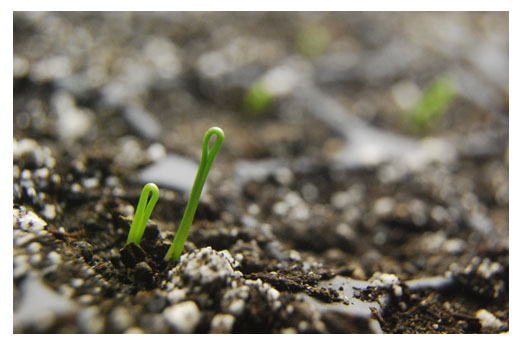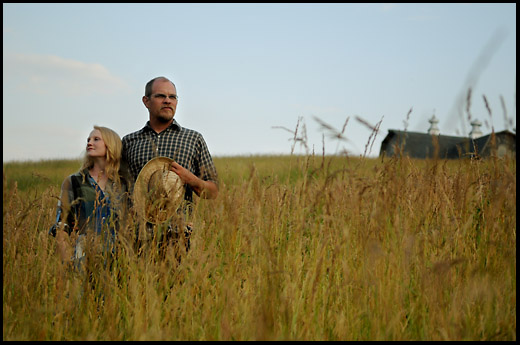
by guest blogger Tim Mountz of Happy Cat Farm
The writer and agricultural shaman Wes Jackson once wrote, “Who takes seriously the slow knowledge, the accumulated mistakes and successes over generations?”
Well Mr. Jackson, I do, or at least I am trying to.
I was raised by my parents to be a very inquisitive naturalist. We were always on a mission to see a bird or turn over rocks to see what we could find. Armed with only curiosity and Peterson’s guides, we rushed headlong into every season. We were fledgling phenologists, consulting the stars in our great quest for direction on an amazing voyage into the seas of slow knowledge.
All people who grow things know this, if they understand it or not. Growing things takes time and patience—some seeds can take years to germinate, some soils take years to build up. Compost does not happen in a day. This is why I like the company of gardeners and farmers, not just for the humility that dirty fingernails brings, but also because they are just about the last people on earth who have patience in this ever-faster spinning world.
Every year on February 2nd, on a chilly hill in the middle of Pennsylvania, a fuzzy little critter named Phil is dragged out of his hole in front of throngs of bundled-up people who have spent the better part of the night standing on that frozen hill waiting for him. Groundhog Day, or Grundsau, as we say in PA German, is part of an older celebration called Candlemas, which is part of an older pagan celebration—all of which are really about light. The old farmers would say, “groundhog’s day, half your hay.” Basically, hold on, you’ve almost made it.
I stood on that cold hill a few years back and watched as Phil saw no shadow and the people all cheered. I wondered how many of them made the connection from their groundhog hats to slow knowledge. For us farmers, it’s the time to wake up and start planning, cleaning pots and getting seeds organized and started under lights.
But the groundhog is only one symbol of the slow knowledge we farmers have come to understand. Not long after the 2nd of February, the bare Eastern trees and the buff brown meadows will be dotted with the most intense blue that you can imagine. It is the male bluebirds coming to scout out summer breeding territory. For me, that sign means that I had better get my long-season plants seeded into their trays and started.
Then, sometime around the first week of March, we start to hear a familiar twill down in the marshes. From the reeds and thickets comes one of the best songs you will hear. The red-winged blackbirds have returned and are trying to pick turf and find a lady friend. This is the sign for me to start the rest of my seeds under lights—the tomatoes, peppers, and eggplants. You hear the birds before you see them. It’s slow knowledge affecting all of the senses, letting us know that spring’s bounty is coming.
When day length becomes about 11 hours, the soil warms and everything seems to be on the move. We will till the fields, work the land, and plant peas, potatoes, onions, and cold-loving greens. By St. Patrick’s Day, we hear the symphony of spring peepers, tiny tree frogs that lay eggs in wet areas, and we take heart because spring is here.
And then, right around the time we can plant freely in the fields, when daylight is long, soil temps are up, and frost is a blip on the radar heading in the other direction, another wonderful event, and bit of slow knowledge, happens. There is a cherry tree that grows by the old creamery on the property where I live. When the pink petals start to fall off of the tree, I know that the chimney swifts will return within a week, and their nightly dance of flying in a big circle and going into the chimney one by one will be my evening’s entertainment all summer long.
 Tim and his wife Amy own Happy Cat Farm, an organic farm and lifestyle brand located just outside of Kennett Square, PA. www.happycatorganics.com
Tim and his wife Amy own Happy Cat Farm, an organic farm and lifestyle brand located just outside of Kennett Square, PA. www.happycatorganics.com
Top photo credit: Meredith Langer




I live six miles from Kennett Sq., and have never heard of this farm. Can it be visited by the public? It is good to know the existence of this farm. Thanks for the blog.
Maria–what a timely article as Spring does her best to overcome Old Man Winter here in middle Tennessee! The Bradford pears have bloomed but her counterparts are holding out for warmer weather! The poor daffs have endured many sub 30 nights but are standing strong……we ALL are more than ready for warmer days/nights.
I, too, am a fifty- something reared in a resourceful environment and am saddened by the fast-paced convenient lifestyle that has become the norm. We are raising our kids slightly ‘going against the grain’ but know they will be better stewards of this Earth as a result. Reading your words this morning took me back to childhood in Akron, OH and some very pleasant memories ! Thanks!